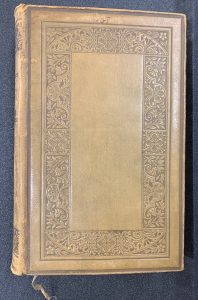
The first edition of La goutte & le rheumatism (Paris 1900) at Falk Library is a lovely copy in a very attractive leather binding. Its author, Armand Delpeuch (1856-1901) was a physician at the Tenon and Cochin Hospital in Paris. In 1900, he published an article in La Presse Medicale, describing a new sign of aortic insufficiency, a rhythmic bobbing of the head synchronized to a heartbeat. He proposed to call it “De Musset’s sign,” after French writer Alfred de Musset, who displayed the same characteristic head-shaking. The eponym coined by Delpeuch is used to this day. He also published the history of the gout from antiquity to the end of the 17th century. It was the authoritative source on the history of this disease for more than half a century.
Delpeuch’s book is not very old or rare, nor is it a unique copy. What is so special about it then? It is valuable because of the context in which this book exists. It is a part of our Rodnan Collection.
 Dr. Gerald Rodnan, former University of Pittsburgh professor and book collector, was one of our most generous donors. He left his personal library on gout and rheumatic diseases to the Falk Library of the Health Sciences. His comprehensive collection consists of almost 700 books, several satirical gout-related prints and drawings, and wooden gout stool foot rests. Among several 16th century works, this subject collection includes the earliest book on gout that he acquired, Pirckheimer’s Apologia seu podagrae laus (1522), and it spans six centuries to the most recent literature added before his death in 1983. It contains unique theses and book chapters, rarities such as Tractatus de podagra et hydrope (1683) by Thomas Sydenham, and a full set of editions of the standard American textbook Arthritis by Bernard Comroe. Is it possible to imagine a complete gout collection without the book on the history of gout? On its own, Delpeuch’s work may not be the most valuable resource in the library, but it is an essential and important part of our gout collection.
Dr. Gerald Rodnan, former University of Pittsburgh professor and book collector, was one of our most generous donors. He left his personal library on gout and rheumatic diseases to the Falk Library of the Health Sciences. His comprehensive collection consists of almost 700 books, several satirical gout-related prints and drawings, and wooden gout stool foot rests. Among several 16th century works, this subject collection includes the earliest book on gout that he acquired, Pirckheimer’s Apologia seu podagrae laus (1522), and it spans six centuries to the most recent literature added before his death in 1983. It contains unique theses and book chapters, rarities such as Tractatus de podagra et hydrope (1683) by Thomas Sydenham, and a full set of editions of the standard American textbook Arthritis by Bernard Comroe. Is it possible to imagine a complete gout collection without the book on the history of gout? On its own, Delpeuch’s work may not be the most valuable resource in the library, but it is an essential and important part of our gout collection.
Please send inquiries to the History of Medicine.
~Gosia Fort